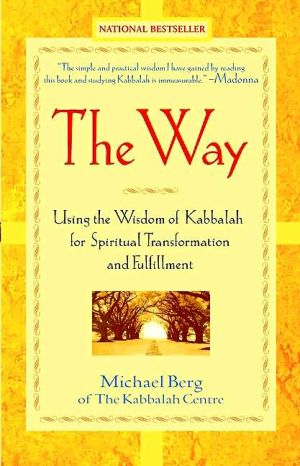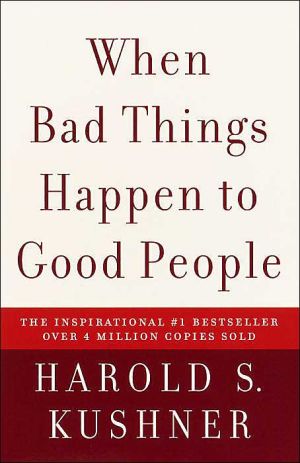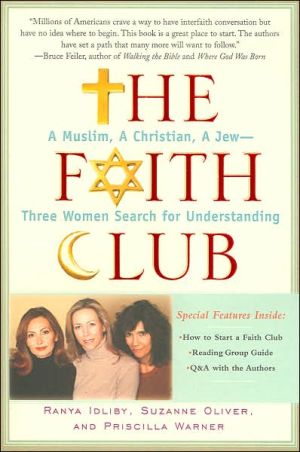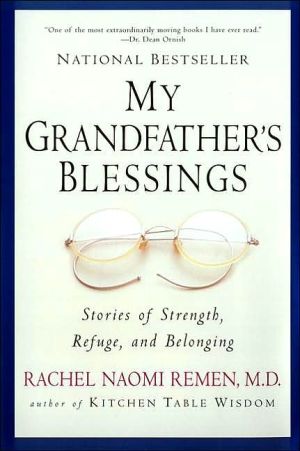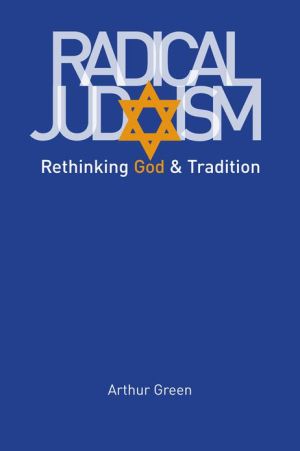The Way: Using the Wisdom of Kabbalah for Spiritual Transformation and Fulfillment
"The simple and practical wisdom I have gained by reading this book and studying Kabbalah is immeasurable."\ --Madonna\ "This book will inspire your soul. Michael Berg has accomplished the monumental task of translating the eternal truths of life into spiritual common sense. Without a doubt, The Way will become one of the sacred texts of your own life."\ -Caroline Myss, Ph.D., author of Anatomy of the Spirit and Sacred Contracts\ The spiritual way of Kabbalah has grown from a hidden treasure...
Search in google:
In this profound and joyful book, Michael Berg of The Kabbalah Centre, the world’s leading educational organization teaching the wisdom of Kabbalah, shows you how to use Kabbalah to bring happiness and fulfillment into your own life and into the lives of everyone around you.The spiritual way of Kabbalah has grown from a hidden treasure–an ancient knowledge reserved for the few–into a widespread mainstream movement that has helped people from every walk of life, all around the world. Thousands of ordinary men and women of all faiths and beliefs are applying its principles to transform themselves and their lives. Both groundbreaking and so clearly written that it is accessible to everyone, The Way is a practical roadmap that will be useful to anyone following any spiritual path.Writing with warmth, wonder, kindness, and a deep insight into both human and divine nature, Rabbi Berg guides you step-by-step along the way to enlightenment. In The Way, you will come to understand the key spiritual laws that guide our lives and our universe and gain a vision of the greater purpose that lies behind everything you do and everything that happens to you. You will learn meditation and prayer techniques. And you will acquire the spiritual, emotional, and psychological power tools that will enable you to reduce emotional chaos, increase personal harmony, and benefit all aspects of your life. Fired by the spark of the divine yet grounded in the here and now, The Way helps you find the path to the Light–the true fulfillment and lasting happiness your deepest self has always sought. Publishers Weekly Berg, the editor-in-chief of Kabbalah magazine, offers a readable introduction into what he claims is the universal mystical tradition. The Kabbalah is replete with modern analogies (even Vince Lombardi!) and is written in an intelligent style expressly designed to appeal to the broadest possible audience. However, Berg overreaches with the claim that "Kabbalah is the birthright of all humanity. It does not belong to any religion or ethnic group." Unless God desires everyone to be Jewish (which Judaism has always rejected), it is disingenuous to say that "The Way" is "for literally everyone in the world" and then proceed to refer exclusively to Jewish texts, prayers, heroes and holidays and the mysterious power of Hebrew and Hebrew alone. Berg's "way" has much in common with other mystical traditions, particularly reincarnation and meditation. "Love thy neighbor" may be "the secret of living in accordance with Kabbalah," but it is hardly a monopoly. Ironically, the path outlined here is reminiscent of St. Paul's ancient Christian missions to the pagans. St. Paul eliminated Jewish ritual observance and made the religion palatable to the uninitiated winning countless converts to a new tradition, but alienating observant Jews. Characterizing the Sabbath as "one day just to sit back and cruise, if that's what we really want to do" may win the hearts of Santana and Madonna, but it will likely leave serious Jewish mystics cringing. (Sept. 7) Copyright 2001 Cahners Business Information.
\ Chapter One\ \ \ Creating Fulfillment\ \ \ * * *\ \ \ Can a person's nature be changed by words on a page? Canletters and words on paper so deeply influence our consciousnessthat we are literally not the same person after we've readthem? I believe—I know—that the material we are about tocover can have this effect. I have heard it over and over again,and I have discussed it and taught it on literally hundreds ofoccasions, and I discover something new every single time.\ Let me preface this key topic with some brief observations.In recent years a number of books have tried to bring the wisdomof Kabbalah to a general audience. The great majority havebeen incomprehensible to most readers, and consequentlythey've failed to have a widespread impact. Not one of thesebooks has discussed the concepts we will be covering in thissection—which is puzzling, since they are absolutely essentialkabbalistic teachings, and they're are also quite easy to understand.\ Right now, before you read any further, please think for amoment about why you're looking at this page at this particularinstant of your life. Are you browsing in a bookstore on yourlunch hour? Perhaps you've been given The Way by a friend, oryou're thinking of giving it as a gift yourself. Whatever theapparent reason, I would ask you to open yourself to anotherviewpoint—to the possibility that this is the exact momentwhen you are most ready to discover these teachings and takethem to heart. Itis said that Rabbi Isaac Luria, named the Ari, orlion, was so attuned to the state of people's souls that he couldoffer the precise teaching that any individual needed to hear atany given point in time. As you read this chapter, be aware thatthis ability on the part of the Ari was an expression of the overarchingintelligence of the universe itself. There is a purpose—thoughperhaps a concealed one—to your reading aboutKabbalah at this moment, just as there is a purpose to my writingabout it. I believe from the bottom of my heart that theteachings, you are about to discover can vastly—immeasurably—changeyour life for the better, and empower you to helpothers in the same way.\ For each of us, life is a search. It may seem as if we're searchingfor different things—some for material wealth, others forknowledge, still others for fame and recognition—but theseobjectives are really just the outward expressions of an essentialinner experience of well-being and joy. Kabbalah refers to thisexperience as fulfillment, a highly significant word.\ Although many people gain brief moments of fulfillmentover the course of their lives, few of us know it as an ongoingreality. It's here and then it's gone, like the flame of a match thatburns for a moment and then becomes a little plume of swirlingsmoke. So our real search is not only for fulfillment, but for away to somehow keep it a presence in our lives. On the verypractical level of our daily experience, the purpose of Kabbalahis to make that happen—to make fulfillment a constant, not justfor each individual, but for the world.\ The tools of Kabbalah presented in this book don't need tobe completely understood at the outset. They just need to beused. But as you use them, be sure to return again and again tothe principles that underlie them, which will also be presentedin these pages. These ideas should be constantly rethought. Aswe'll see, complacency is one of the greatest dangers to realgrowth. If you feel that you've thoroughly understood the conceptsand that there's no need to revisit them, take it as a signthat revisiting is exactly what you need to do.\ I think it's worth mentioning that I didn't make any of thisup. Rather, I am privileged to have studied the wisdom ofKabbalah that has evolved over many centuries, and the purposeof The Way is to share that wisdom with you. There aremany books on spirituality that derive from their authors' lifeexperiences and gain their power from the authors' charisma oreloquence or depth of thought, but this is not one of thosebooks. I do consider myself a reasonably intelligent person andan honest one, but I am not the incarnation of Kabbalah. As theperson who is introducing you to this wisdom, I will try to doso to the best of my ability, but I really want you to focus onwhat I'm saying rather than how I'm saying it. For the few hoursthat you leaf through these pages, I am the medium, but themessage is much larger than me. And I think you'll see justhow vast that message really is as you proceed through thebook.\ \ \ The Creator\ \ \ God is a word that frightens many people, for many differentreasons.\ Over the centuries, a multitude of different meanings andemotions have been attached to the word, many of them decidedlynegative. The word God has been used to strike fear in childrenand to create guilt in adults. It has been used to justifymilitary aggression and political ambition. It has come to signifya powerful and unpredictable entity that exists somewhereacross a vast metaphysical divide—a being about whom it's difficultto say anything definite except that he, she, or it is verydifferent from you or me. We've even heard fear of Goddescribed as if it were a good thing, as when someone is calleda "God-fearing man."\ In short, God is a word that carries a lot of baggage, and youmay be surprised to learn that it's a word used rather sparinglyin the kabbalistic teachings. One reason is the imprecise natureof the word itself. The first sentence of the Torah, for example, isusually translated, "In the beginning God created heaven andearth." A great deal has been written about this sentence, and Iwill have more to say about it soon, but for now let's focus onthe word for God in the original Hebrew text. The Hebrew wordis Elohim, which refers specifically to God's judgment—as distinctfrom God's mercy, or from a more all-inclusive sense ofGod as an omniscient presence. In general, Kabbalah refers toGod as the Creator, or as ein sof, which can loosely be translatedas "the infinite."\ In keeping with this preference, we'll rarely use the wordGod in this book, and most often we'll speak of the Creator.Although we will occasionally use the personal pronoun "He"when referring to the Creator, this is only for the sake of grammaticalefficiency. Kabbalah teaches that a distinction does existbetween male and female energies, but that the Creator transcendsthese gender categories. "He" encompasses both formsof energy. The Creator is an infinite force of positive energy,without beginning or end; the essence of all hope, peace, contentment,mercy, and fulfillment; the source of everything inCreation that opposes the forces of confusion and chaos andsuffering and pain; an endless source of Light; and an unnamabletimeless presence.\ But these are attributes of the Creator, in the same way thatjudgment and mercy are attributes. They are the Creator'screations—but the whole of the Creator is unknowable andbeyond our comprehension.\ \ \ The energy of the Creator is carefully and lovingly distributedin our world, because the Creator's deepest intention is toshare with us peace, joy, kindness, and love.\ \ \ Kabbalah teaches that this sharing permeates the naturalworld—in physical things such as apples and airplanes, as wellas in intangibles such as affection, loyalty, and kindness.Through these and all the other infinite varieties of matter andfeeling, we catch a tiny glimpse—and only a glimpse—of theCreator's nature.\ \ \ The Light of the Creator\ \ \ Kabbalah refers to all these manifestations as the Light of theCreator. The Light is not only knowable, it is something weencounter in one form or another virtually every day. When welook into the eyes of children and are overwhelmed by theirinnocence and perfection, this is an aspect of the Light of theCreator. When we take pride in a job well done, when we treatothers with respect, when we marvel at natural beauty or at abeautifully realized work of art, we are encountering the Light;conversely, sadness, loss of hope, and negativity in our lives areexpressions of our separation from the Light. Kabbalah tells usthat the feelings of peace, joy, and understanding that we gainfrom experiences of the Light in the physical realm only hint atthe infinite fulfillment that is the Creator's essence. Andwhether we realize it or not, it is union with this essence thatwe're all searching for.\ Unfortunately, the real meaning of this union and of the fulfillmentthat it brings are difficult concepts for most people tounderstand. Very often they're misconstrued as money, fame,power, or other tangible and temporary attributes of everydaylife. Many of us are searching for those things, and we takepleasure in the excitement and satisfaction that they bring. Butwhat if there were a way to make fulfillment a permanentpresence, not just in your own life, but for literally everyone inthe world?\ The principles of Kabbalah introduced in this book guaranteethat fulfillment. They just need to be used, and they canbe used even before they're fully understood. Intellectualunderstanding is not the ultimate goal. Thinking about the concepts—andespecially putting them into action in the realworld—are what counts.\ \ \ Kabbalah gives us the tools to stay connected to the Creator'sLight, and we accomplish this by drawing out the Lightthat is already within us.\ \ \ We don't have to reach out to acquire anything new. Weonly need to take control of the power that has already beengiven to us. In fact, this power, the Light of the Creator, is thevery stuff of which we are made—and deep down, we know thisto be true. We feel that there's something transcendent withinus, if only we could somehow make contact with it.\ Much research has demonstrated that the overwhelmingmajority of us believe in some form of higher power, and manybelieve in God in a very traditional sense: God is all-powerful,and God is good. But how can an omnipotent, benevolent Godallow the obvious pain and suffering that afflict our world tocome into being, much less continue and even intensify? Is itnaive to declare that this just doesn't make any sense?According to Kabbalah, it's not in the least naive. It's a majorrealization, and it's also the first step toward understandingwhat the Creator really intended. By revealing the Light of theCreator in ourselves and in the world around us, we can at lastrealize that intention. We can bring peace, joy, and fulfillment toall mankind.\ \ \ The rocky path to transformation\ \ \ Not long ago a student at the Kabbalah Centre in Los Angelesadopted a baby from China. Lori was nine months old at thetime of her adoption, but her physical development was that ofa child at least four months younger. She had spent almost herwhole life lying flat on her back in an orphanage crib. She couldnot sit up or even roll over by herself. The back of her head hadactually begun to flatten out due to her lack of mobility, andthere was a large bald spot where her hair had been unable togrow.\ When she arrived in America, for the first time Lori had achance to move around on her own. Following the instructionsof their pediatrician, her parents put a blanket on the floor andgently placed Lori in the center of it. At first she was so terrifiedthat she seemed to enter a sort of trancelike state in order toescape the new and completely disorienting situation in whichshe found herself. And if any attempt was made to turn herover or stimulate her, she cried bitterly and quickly returned toher "comfort zone" on her back. To her parents, Lori seemed tobe making no progress at all—yet Lori's doctor was surprisinglyconfident. There was no evidence of underlying neuromusculardamage, and, as the doctor put it, "Lori will eventually learn towalk because that's what she is meant to do. She's also meant toexperience difficulty in walking, so that by overcoming thosedifficulties she can become stronger."\ Before long, day by day, Lori began to make progress,though at first even the smallest transitions seemed terriblypainful. If she managed to turn over, she immediately cried outin pain and again rolled onto her back. But later—sometimesafter an hour, and sometimes after a full day—she would tryagain. Gradually progress happened more quickly, and withinsix months what had once seemed impossible had become reality.Lori had caught up. She could do everything that was to beexpected of a child her age.\ Why did Lori not simply give up when her first attempts atgrowth were so painful? Why did she not behave in accordancewith a behaviorist model of pain avoidance? Why did this child,in her small way, choose to transform herself from one mode ofexistence to another? The answer, as her doctor pointed out, isthat it was in her nature to do so. The difficulties she experienced,however painful they may have seemed, were simply ofa different order of magnitude than the deeply ingrained objectiveof learning to walk.\ On the path to transformation, you will undergo exactly thissort of experience. The path includes many obstacles, but theobstacles themselves are opportunities to renew your journeytoward joy and fulfillment. It's misleading to speak of Kabbalahas difficult or demanding, because that places emphasis in thewrong place. Again, the obstacles are of a different order of magnitudethan the objective. When you learned to walk, to speak, toread, or even to ride a bicycle, there were certainly mistakes andscraped knees and perhaps even a broken bone or two, but itwas in your nature to accept and even to seek out those experiencesas the price of positive change and ultimate fulfillment.\ This—not sorrow, pain, or death—is your true destiny. Butyou are not just a recipient of this fulfillment. The Creatorintends for you to be an essential participant in bringing itabout, using the spiritual tools of Kabbalah that have beengiven to all mankind.\ The Way is a user's manual for those tools. But it is not aquick fix. As we've discussed, transformation is not easy, nor isit supposed to be easy.\ (Continues...)\ \ \ Excerpted from The Way by MICHAEL BERG. Copyright © 2001 by Michael Berg. Excerpted by permission. All rights reserved. No part of this excerpt may be reproduced or reprinted without permission in writing from the publisher. \ \ \ \ \ SEEING TOMORROW\ Rewriting the Rules of Risk\ \ \ By RON S. DEMBO, ANDREW FREEMAN\ \ JOHN WILEY & SONS, INC.\ Copyright © 1998 Ron S. Dembo and Andrew Freeman. All rights reserved.\ TAILER
AcknowledgmentsxiIntroduction1The night fear4The benefits6Using this book7Questions to keep in mind8Part 1The Way of KabbalahChapter 1Creating Fulfillment11The Creator14The Light of the Creator16The rocky path to transformation18Accomplish what you came here for20Chapter 2Kabbalah through the Ages24Abraham created a portal25The powers of the letters26The Zohar28Rabbi Luria and tikkun29Opening to the Light30Advanced Kabbalah32Chapter 3The Light and the Vessel35Light and Vessel: The metaphysics of creation36The Light38The Vessel39The shattering40Reconnecting with the Light43The four central principles of the Way45Our own best interests46The intention of sharing47The story of one people--and of all people49The inner creation51The death of death53The Rabbi and the Landowner53The Upper Worlds57You have to earn it58Part 2Getting Ready for the LightChapter 4The Work of Living63The one-directional pathway65Proactive versus reactive66Going against our nature68Positive and negative, light and dark70We're all in the same boat71Take action in the real world73Put together the jigsaw puzzle73The source of pain and suffering75What is evil?76There are spiritual laws79The element of choice80Wheels of the Soul82Use your time well85Chapter 5Building a Relationship with the Creator88A Great Gift, Well Disguised89Ask for it91The Master Builder93When you believe it, you'll receive it94It is never too late94Higher than the angels, lower than the worms95The Hell Within96Chaos and the meaning of angels100Without the Creator we are less than nothing103The Dark Angels, the Light Angels, and the Gray Angels105Chapter 6The Twelve Spiritual Laws of the Way1091.Know that every day is an opportunity for transformation1102.Hear the Voice from Above1103.Understand that we are all mirrors1114.Trust in the Creator--emunah112The Rabbi and the Train1125.Ask for divine assistance1166.Realize that we are always being tested1177.Repent with joy121Cleaning the Barn1228.Be never satisfied123The Three Judges1239.Walk like the blind12710.Use death as a motivation12811.Experience the pain as our own12912.Don't judge others131Part 3Spiritual TransformationChapter 7Understanding Our Thoughts and Feelings135Live with joy136Appreciation brings joy137Realize that envy is a constant temptation139Know all the meanings of fear142We are truly not alone143Always be aware of anger144Embrace love146Chapter 8Using the Spiritual Tools149Share150Our Inner Nature150Sharing in Action1541.Be before doing1542.Be ruthless and without mercy1553.Realize that difficulties are more apparent than real156Practice charity157Charity in Action1601.Give every day1602.Know what to give1603.Start small1614.Keep it quiet1635.Remember that money isn't everything164Pray165An Open Heart169How to Pray1721.Love your neighbor1722.Replace doubt with certainty1733.Pray the way that works best for you1744.Pray for others1755.Understand the answers176Practice Shabbat, the Sabbath177Observing Shabbat1821.Wear something special1832.Be charitable1833.Greet Shabbat1834.Sing Shabbat songs1845.Give blessing184Celebrate holidays and miracles185Making Miracles Happen1891.Shift your perspective1892.Pay attention to miracles1903.Borrow on your tzaddik191Study193Study in Action2021.Know where you're starting from and where you want to go2022.Pay attention2033.Give thanks2034.Scan the Zohar204Practice introspection and mediatation205The Near-Catastrophe and Its Lesson207Kabbalistic Meditation Techniques2111.Practice breathing meditation2112.Meditate on sacred verses2133.Practice spiritual conversation2144.Practice listening meditation2165.Practice creating love and forgiveness2176.Practice music meditation2207.Practice proactive visualizations221Go into daily life225Chapter 9Sharing the Way226Kabbalah's answers to the fundamental questions227A call to action230The Envelopes Slipped under the Doors232Glossary238Bibliography and Sources for Further Reading240Index241
\ From Barnes & NobleKabbalah is an ancient mystical tradition, but it still enjoys widespread popularity among people of all faiths. Author Michael Berg, the editor-in-chief of Kaballah magazine, is an engaging thinker who is eager to apply the Kaballah's esoteric principles to postmodern life.\ \ \ \ \ Publishers WeeklyBerg, the editor-in-chief of Kabbalah magazine, offers a readable introduction into what he claims is the universal mystical tradition. The Kabbalah is replete with modern analogies (even Vince Lombardi!) and is written in an intelligent style expressly designed to appeal to the broadest possible audience. However, Berg overreaches with the claim that "Kabbalah is the birthright of all humanity. It does not belong to any religion or ethnic group." Unless God desires everyone to be Jewish (which Judaism has always rejected), it is disingenuous to say that "The Way" is "for literally everyone in the world" and then proceed to refer exclusively to Jewish texts, prayers, heroes and holidays and the mysterious power of Hebrew and Hebrew alone. Berg's "way" has much in common with other mystical traditions, particularly reincarnation and meditation. "Love thy neighbor" may be "the secret of living in accordance with Kabbalah," but it is hardly a monopoly. Ironically, the path outlined here is reminiscent of St. Paul's ancient Christian missions to the pagans. St. Paul eliminated Jewish ritual observance and made the religion palatable to the uninitiated winning countless converts to a new tradition, but alienating observant Jews. Characterizing the Sabbath as "one day just to sit back and cruise, if that's what we really want to do" may win the hearts of Santana and Madonna, but it will likely leave serious Jewish mystics cringing. (Sept. 7) Copyright 2001 Cahners Business Information.\ \
